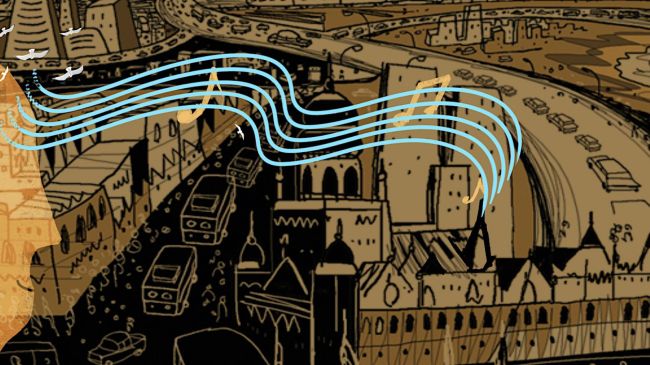Opinion Falling in love with Mumbai, the city of music
There is no chronological neatness to the history of Mumbai’s music. Long a home to itinerants, it is not a surprise that alongside Hindustani classical, Western classical music and jazz too have thrived here
 A port city with many performance venues, a thriving movie industry, and even more takers of all forms of entertainment, Mumbai helped turn music into a serious business in India.
A port city with many performance venues, a thriving movie industry, and even more takers of all forms of entertainment, Mumbai helped turn music into a serious business in India. Written by Sangeeta Chakravorty
Sometimes our love for a city is akin to a reputation laundering scam. In Mumbai, we force ourselves to forget what takes place every monsoon, the daily gruel of enduring the “super-dense crushload” of suburban train travel and the bruising injustice of being driven out of one’s neighbourhood as real-estate developers alight on every square inch of the city. I think of this as the Big Crumbling — and if you look long enough, it takes hold from the inside.
Yet each year, many like me come to Mumbai to find a kind of home. I moved here with a shiny new job and, with it, a burnished personhood. And since it was a beginning of sorts, it made sense to leave behind the music of my former life, chosen by my parents, to firmly grasp something new. And it seemed to me that with its sheet music, pianos, and very grown-up concerts, western classical music promised what I was seeking.
Raised steeped in Bengalism by very musically-inclined parents, I had to make an effort to learn music in Mumbai. It was a cultural revelation — which other city offers such easy access to musical concerts in various genres, theatre in regional languages, or newspapers in various languages? A port city with many performance venues, a thriving movie industry, and even more takers of all forms of entertainment, Mumbai had helped turn music into a serious business in India.
Through the whisper network that newbies rely on, I found Roshan Chowna, a South Bombay gem who had recently moved back from Calcutta where she taught at the famed Calcutta School of Music. Another itinerant. She had the unique distinction of being trained by Olga Craen, the first conductor of the Symphony Orchestra of Bombay and one of India’s most distinguished pianists and music educators. Craen’s musical legacy remains unparalleled — can you name another teacher who organised musical performances by her pupils at the Taj Mahal Palace Hotel? — and remains a beloved Mumbai tale.
A music teacher invites you to their home, and through a unique stripping of ego, imparts the kind of education that leaves a lasting impact. They are never quite family, but the bond is as rich. I will never forget making my way to my teacher’s home, near a tree-shaded locality, every Saturday morning for a class. Her undiminished listening abilities, her arthritic fingers that could still coax sublime melodies out of the ivory keys, all the while supervising the cleaning of her home. She was 90 when she chose me as her pupil.
After her passing, when the grief of her loss no longer stopped my hands from searching for music, I found the sitar, with its densely layered association with the world of classical music (as seen in Chaitanya Tamhane’s 2020 film The Disciple). Mumbai, home of the Bhendi Bazaar gharana that emerged in 1890, has a unique place in the history of Hindustani classical music. Renowned musical scholar, tabla maestro and composer Aneesh Pradhan has written about the trading community of shetias being early patrons of music in Mumbai (well-timed with the decline of princely patronage elsewhere in colonial India). In Hindustani Music in Colonial Bombay, Pradhan describes a rich musical world in what was then Bombay, with the city playing a big part in preserving the musical heritage. The Bangalore-based cultural theorist Tejaswini Niranjana says that without Mumbai, “Hindustani music would not have survived the way it did.” In an interview, she stated that “a love for Hindustani music brought diverse kinds of people together, contributing to how a sense of the public developed in Mumbai.”
My sitar teacher is a gentle human. He too came to this city from somewhere else. He lives in a sprawling flat surrounded by music and grandchildren. Before each class, we talk about music – jazz, Bach, the blues, other ustaads. These classes have turned me away from the daily cynicism of Mumbai.
There is no chronological neatness to the history of Bombay’s music. Long a home to itinerants, it is not a surprise that alongside Hindustani classical, Western classical music and jazz too have thrived here — thanks in large part to Goan musicians who were already steeped in the Western classical form, and helped develop a unique jazz scene in Bombay, with homegrown stars like Chic Chocolate, Chris Perry and Lorna Cordeiro. Many, such as Chocolate, Perry and Anthony Gonsalves also had a hand in shaping Hindi film music, bringing in elements of jazz and Western classical. Their story has been beautifully told by Naresh Fernandes in his book Taj Mahal Foxtrot.
Such a confluence of creativity can only happen in Mumbai, where, till date, there are thriving communities for all kinds of music, from classical to jazz to Bollywood and rock. Music lovers like me will always find their niche in this city, even when we are cramped for space.
The writer is an MA IR candidate at School of Advanced International Studies, Johns Hopkins University





